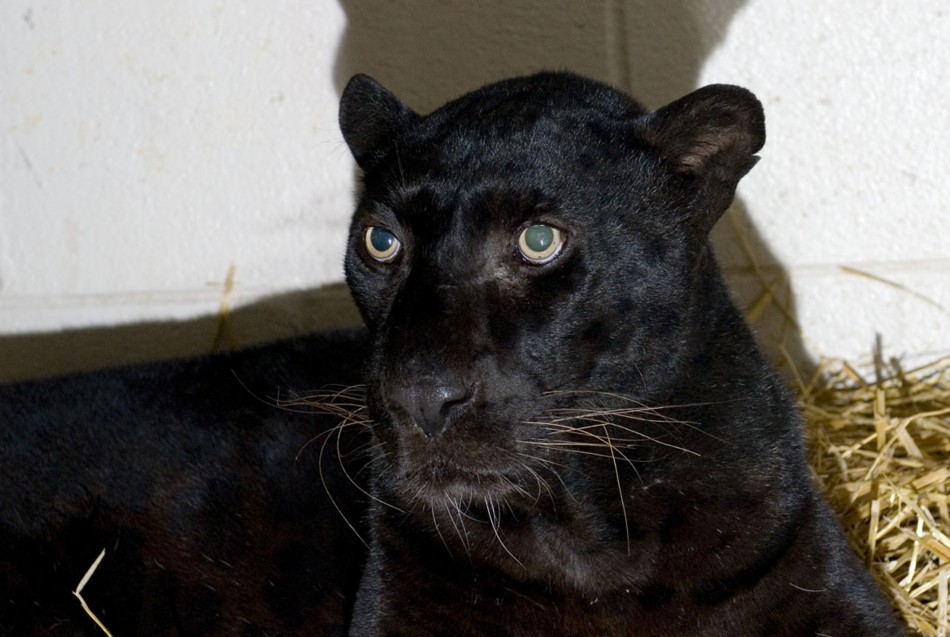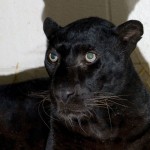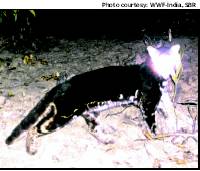Terribly Misinformed News Department: “Black Cat” = “New Species”?
Posted by: Loren Coleman on March 28th, 2012

What? The Sunderbans is the only tiger reserve in India where leopards have never been seen. Its Bangladeshi side reported the last sighting of a leopard in 1931, says the Times of India. So, what is the media doing with the sighting of a “black cat”? Declaring it might be a new leopard species. Declaring it may be a new species of black leopard-cat. Calling it a mystery cat. Now wait a second.
In the early days of the human attempts to name all the beasts and birds of the air, water, and earth, men and women made a common mistake. They thought that the color of an animal meant it was a different species than its spotted, striped, or plain colored brother or sister.
It appears that the same thing still happens today. From South Asia comes this story of a small melanistic cat that the media is trying to make into a new species. It just isn’t so. Reader beware. Video watcher beware.
A species of black leopard unknown to science has been captured on film in the Sunderbans, in Eastern India and Bangladesh. The times of India reported seeing this amazing discovery through camera traps that were set up to capture footage of tigers, but instead discovered a new species of never before seen cats.
The animal has been described as being a small black cat with a long tail, and its specie is unknown to zoologists, but it is believed to be related to the black leopard. The new species is bigger than a wild cat but smaller than the more familiar leopard. There is a possibility that the cat is a melanistic leopard-cat, which is black all over but officials are saying it’s more likely to be an entirely new species.
The Sunderbans is the only tiger reserve in India where no leopards have ever been spotted. And now it appears that an entirely new species of a black leopard has been discovered. Source.
UPDATE:

This stock footage photo appears to merely be a common melanistic Asian leopard.
As Cameron A. McCormick correctly points out, the following are the apparent photos of the “new” cat, which appears to be a melanistic leopard cat:


About Loren Coleman
Loren Coleman is one of the world’s leading cryptozoologists, some say “the” leading living cryptozoologist. Certainly, he is acknowledged as the current living American researcher and writer who has most popularized cryptozoology in the late 20th and early 21st centuries.
Starting his fieldwork and investigations in 1960, after traveling and trekking extensively in pursuit of cryptozoological mysteries, Coleman began writing to share his experiences in 1969. An honorary member of Ivan T. Sanderson’s Society for the Investigation of the Unexplained in the 1970s, Coleman has been bestowed with similar honorary memberships of the North Idaho College Cryptozoology Club in 1983, and in subsequent years, that of the British Columbia Scientific Cryptozoology Club, CryptoSafari International, and other international organizations. He was also a Life Member and Benefactor of the International Society of Cryptozoology (now-defunct).
Loren Coleman’s daily blog, as a member of the Cryptomundo Team, served as an ongoing avenue of communication for the ever-growing body of cryptozoo news from 2005 through 2013. He returned as an infrequent contributor beginning Halloween week of 2015.
Coleman is the founder in 2003, and current director of the International Cryptozoology Museum in Portland, Maine.










I don’t understand what’s going on in zoology anymore. When I was studying the subject (intensively—albeit a long time ago) I was taught that it was a major no-no to use coloration as a taxonomic classifier, as it was considered the most unreliable and ambiguous of all indicators. As time went along I watched it become more and more prominent and accepted as a tool for biological classification. Now, as in this case, we see that coloration is “The” determining characteristic in species determination. Among other things it sounds like a zoologist’s laziness to me. Most probably this is but another unfortunate example of some senior ranking university zoologist’s self-aggrandizement.n
I agree: from what I can see it is an Asian leopard cat; (Prionailurus bengalensis begalensis).
I’ve posted here before on the jaguars living in the Gadsden Purchase area of New Mexico. Despite the story the link below this article takes one to, there has always been more than a single jaguar in this country. These cats are rare in New Mexico and Arizona, but hardly unknown. Just a small local population.
I would not be surprised if these cats were also to be found in the Big Bend area of Texas as well.
I’m satisfied that the cat shown in today’s blog is a melanistic leopard. Jaguars have a melanistic variation as well, and I have heard first-hand accounts of sightings in New Mexico.
Jaguars can run a bit larger than leopards. They are the third largest natural cat species. A melanistic jaguar will have spots that are visible under bright light. I do not know if the melanistic leopard shares this trait, but would not be surprised if it did.
So far, I do not see a cryptid mystery here. The cryptid mystery is the sightings of melanistic great cats in areas of this country not frequented by jaguars. These sightings are described as “black cougars”, “black mountain lions”, or “black panthers”.
The problem is, there is no known melanistic phase of cougars. There is indeed a black panther, but that is an African animal, not the same species as the American Panther, which is just another name for the cougar.
So, the real mystery black cats are in North America, not India.
Don’t know what that is, exactly.
But I sure wouldn’t say leopard, and color’s not the reason. It’s a small cat.
DWA,
My thoughts, too.
The two photos of the small cat were not shown at the time I posted above. Only the big cat was shown.
These small cat photos may not even be a wild cat. It looks a lot like a domestic cat to me.
The Brevard Zoo in Melbourne Florida used to have a melanistic Jaguar. At 25 feet lying in the shade it looked completely black. However when sunlight hit it, you could faintly see the chevrons.
Just wanted to update you guys on this AP photo. This is actually Anthony a survivor of the Zainesville, Ohio tragedy. He’s been locked in quarantine for almost 6 months at Columbus Zoo in Ohio. And the update is correct he is just a common leopard but a leopard with a hell of a sad story. As for the small cat “discovered” it’s extremely hard to make a call on what I am looking at.
Jaguars are considerably larger than leopards. In both cats size seems to be related to geography; in the jaguar the largest males are almost 375 lbs. This closely approximates an African lioness or a Bengal tigress. The first time I observed an adult jaguar was at the Newport News SPCA and I was astonished at the size when viewed up close and personal.
My first post in this topic (above) was made from memory of the animal; (leopard cat) I was quite surprised to see how far off I was.
The larger picture most resembling the old world leopard (Panthera pardus) in profile. Of course melanistic examples are relatively common. The small (lower) pics are extremely similar to the photo of an Asian leopard cat, (Prionailurus bengalensis); which really does look pretty exactly like a tabby cat. The Asian leopard cat, (Prionailurus bengalensis) is about the size of a large tabby cat topping off at 9 lb. The have been hybridized with domestic cats and are known as Bengal cats in the pet trade. I know a lady with an F2 Bengal cat and it was quite the handful climbing her curtains and attacking her boyfriend etc. She finally had to have it declawed as it was tearing everything up.
But after refreshing my spotty memory with my copy of volume II; Walker’s Mammals of the World; 3rd ed. I see that; (Prionailurus bengalensis); [then felis bengalensis] looks identical to our mystery cat except in coloration. I really believe; (as is the habit of newspapers everywhere); the Times of India” resorted to file photos of any melanistic leopard they could find in order to complete the header.
@desertdweller: The sighting in question happened in the Sunderbans; (pronounced suonderbuns) in Southeast Asia, so I’m a little bit confused by your post. The “new species story” showed up in the “Times of India” not in a SW United States paper. Interestingly the Sunderbans is where the vast majority of tigers are all confirmed man-eaters because of the acquired taste for human flesh developed as a result of thousands of flood victim corpses being carried into the mangrove jungles by the high tides etc.
In any case my money is on the “new Species” being a melanistic leopard cat
Opalman,
The article I was referring to in my post was “New Jaguar Sighted in Arizona”, a link provided below the Black Cat article.
There seems to be a misconception in the media that we only get jaguars in this country one at a time. When in fact, the jaguar, while certainly uncommon, is hardly unknown in the mountains of New Mexico and Arizona. While working there, in 2009, 2010, and 2011, I heard many first-hand accounts of encounters with these animals, and was even taken to the site of one of the encounters.
Some of these jaguars are melanistic. Melanistic big cats are reported in many places in the US, although cougars, our more common large cat, do not exhibit a melanistic variation.
What, then, are people seeing? This, to me, is the real black cat mystery.
The big cat pictured in the article above is a melanistic leopard. Fine. Melanistic jaguars can be even larger. I saw a photo of a jaguar killed in Arizona (not melanistic) that went 400 pounds.
The little cat in the photos looks to me like a Bengal cat. These are beautiful domestic pets, hardly a mystery.
If I had a cat tearing up the house, I would try behavior modification. I cannot support declawing. It is the equivalent of cutting fingers off at the first joint, and is illegal in some countries and states.
Guess we are getting off topic…
But Jaguars could be plausibile for large “black cat” reports in the lower southern tier of US states, melonistic or not. I hope most of us understand the unreliability of eyewitness testimony.
@desertdweller; Got it. The way the report and editorial is laid out was a bit confusing to me. I agree that the issue of American jaguars is being terrifically under reported by NPS and others, As time goes on I am increasingly of the opinion that the jaguar is making a remarkable comeback in the states.
I also agree that it is cruel to declaw cats just as it is to perform a Venomectomy on a reptile; they needing the various enzymes to predigest their food. I had no say in the matter with the cat. Around the time I was hanging out in Sussex N.J. I also worked for a vet who boarded a cougar “Shandi” there; (it being exiled from Manhattan). She was also declawed, but I think back on those days and am glad she was. I Can’t tell you how many times she smacked hell out of me, sometimes giving me a black eye or bloody nose; all in playfulness. They’re tremendously strong creatures.
I cannot really figure out why the NPS keeps so many secrets like this and other things I looked into. I learned a long time ago filing a FOIA request is a total waste of time; and things are getting worse not better.
Opalman,
Maybe I am too cynical, but I think the reason comes down to money.
If a state confirms that it is home to a native species, then it has to come up with and implement a management plan for that species. If the animal is not native to the state, no problem unless it creates problems (cost people money) as an invasive species.
This is why “out of place” cougar sightings are always attributed to mistaken identity, or as considered “escaped pets” or long-distance wanderings of individual animals. At least the “circus train wreck” reason isn’t used anymore.
My experience with declawed cats is that they tend to bite. They have been deprived of their primary weapons, and might even suffer phantom pains from their amputated digits.
I think Bigfoots are real. Sooner or later, a body will turn up. Expect to hear State Governments say, “Yeah, it’s real and you’ve got one. But it didn’t come from here! It must have wandered in from (fill in the blank).
This has bothered me about zoology classifications for a long time. something has a longer/shorter tail, something is a bit bigger or smaller than average, it isn’t where most of its kind normally lives. Therefore, it is a new species!
With all the variation on nature, I would think we should have some very hardcore, determining factors before we go jumping to conclusions. I hear this a lot every time a new slightly different type of prehistoric hominid bone is found. Must be the new missing link or a previously unknown human ancestor. Sorry, but I need more than a slight variation.